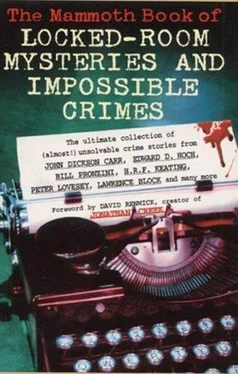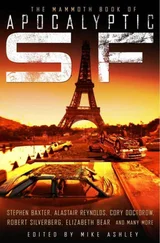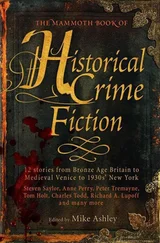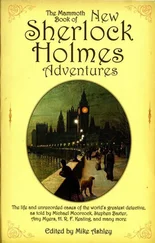Mike Ashley - The Mammoth Book of Locked-Room Mysteries And Impossible Crimes
Здесь есть возможность читать онлайн «Mike Ashley - The Mammoth Book of Locked-Room Mysteries And Impossible Crimes» весь текст электронной книги совершенно бесплатно (целиком полную версию без сокращений). В некоторых случаях можно слушать аудио, скачать через торрент в формате fb2 и присутствует краткое содержание. Жанр: Детектив, на английском языке. Описание произведения, (предисловие) а так же отзывы посетителей доступны на портале библиотеки ЛибКат.
- Название:The Mammoth Book of Locked-Room Mysteries And Impossible Crimes
- Автор:
- Жанр:
- Год:неизвестен
- ISBN:нет данных
- Рейтинг книги:3 / 5. Голосов: 1
-
Избранное:Добавить в избранное
- Отзывы:
-
Ваша оценка:
- 60
- 1
- 2
- 3
- 4
- 5
The Mammoth Book of Locked-Room Mysteries And Impossible Crimes: краткое содержание, описание и аннотация
Предлагаем к чтению аннотацию, описание, краткое содержание или предисловие (зависит от того, что написал сам автор книги «The Mammoth Book of Locked-Room Mysteries And Impossible Crimes»). Если вы не нашли необходимую информацию о книге — напишите в комментариях, мы постараемся отыскать её.
A new anthology of twenty-nine short stories features an array of baffling locked-room mysteries by Michael Collins, Bill Pronzini, Susanna Gregory, H. R. F. Keating, Peter Lovesey, Kate Ellis, and Lawrence Block, among others.
The Mammoth Book of Locked-Room Mysteries And Impossible Crimes — читать онлайн бесплатно полную книгу (весь текст) целиком
Ниже представлен текст книги, разбитый по страницам. Система сохранения места последней прочитанной страницы, позволяет с удобством читать онлайн бесплатно книгу «The Mammoth Book of Locked-Room Mysteries And Impossible Crimes», без необходимости каждый раз заново искать на чём Вы остановились. Поставьте закладку, и сможете в любой момент перейти на страницу, на которой закончили чтение.
Интервал:
Закладка:
Then came the crash, the rending of timbers, and silence save for the grinding whir of the motor. Big John ran to the end of the wharf and peered down. The speed of the motor had driven the boat half way upon a float which careened perilously. The man had been thrown forward and lay huddled up face downward and motionless on the float. The dirty water lapped at him greedily.
Big John was the first man on the float. He crept cautiously to the huddled figure and turned it face upward. He gazed for an instant into wide staring eyes then turned to the curious ones peering down from the dock.
“No wonder he didn’t stop,” he said in an awed tone. “The durned fool is dead.”
Willing hands gave aid and after a minute the lifeless figure lay on the dock. It was that of a man in uniform – the uniform of a foreign navy. He was apparently forty-five years old, large and powerful of frame with the sun-browned face of a seaman. The jet black of moustache and goatee was startling against the dead colour of the face. The hair was tinged with grey; and on the back of the left hand was a single letter – “D” – tattooed in blue.
“He’s French,” said Big John authoritatively, “an’ that’s the uniform of a Cap’n in the French Navy.” He looked puzzled a moment as he stared at the figure. “An’ they ain’t been a French man-o’-war in Boston Harbor for six months.”
After awhile the police came and with them Detective Mallory, the big man of the Bureau of Criminal Investigation; and finally Dr Clough, Medical Examiner. While the detective questioned the fishermen and those who had witnessed the crash, Dr Clough examined the body.
“An autopsy will be necessary,” he announced as he arose.
“How long has he been dead?” asked the detective.
“Eight or ten hours, I should say. The cause of death doesn’t appear. There is no shot or knife wound so far as I can see.”
Detective Mallory closely examined the dead man’s clothing. There was no name or tailor mark; the linen was new; the name of the maker of the shoes had been ripped out with a knife. There was nothing in the pockets, not a piece of paper or even a vagrant coin.
Then Detective Mallory turned his attention to the boat. Both hull and motor were of French manufacture. Long, deep scratches on each side showed how the name had been removed. Inside the boat the detective saw something white and picked it up. It was a handkerchief – a woman’s handkerchief, with the initials “E.M.B.” in a corner.
“Ah, a woman’s in it!” he soliloquized.
Then the body was removed and carefully secluded from the prying eyes of the press. Thus no picture of the dead man appeared. Hutchinson Hatch, reporter, and others asked many questions. Detective Mallory hinted vaguely at international questions – the dead man was a French officer, he said, and there might be something back of it.
“I can’t tell you all of it,” he said wisely, “but my theory is complete. It is murder. The victim was captain of a French man-of-war. His body was placed in a motor boat, possibly a part of the fittings of the warship and the boat set adrift. I can say no more.”
“Your theory is complete then,” Hatch remarked casually, “except the name of the man, the manner of death, the motive, the name of his ship, the presence of the handkerchief and the precise reason why the body should be disposed of in this fashion instead of being cast into the sea.”
The detective snorted. Hatch went away to make some inquiries on his own account. Within half a dozen hours he had satisfied himself by telegraph that no French was craft had been within five hundred miles of Boston for six months. Thus the mystery grew deeper; a thousand questions to which there seemed no answer arose.
At this point, the day following the events related, the problem of the motor boat came to the attention of Professor Augustus S.F.X. Van Dusen, The Thinking Machine. The scientist listened closely but petulantly to the story Hatch told.
“Has there been an autopsy yet?” he asked at last.
“It is set for eleven o’clock today,” replied the reporter. “It is now after ten.”
“I shall attend it,” said the scientist.
Medical Examiner Clough welcomed the eminent Professor Van Dusen’s proffer of assistance in his capacity of MD, while Hatch and other reporters impatiently cooled their toes on the curb. In two hours the autopsy had been completed. The Thinking Machine amused himself by studying the insignia on the dead man’s uniform, leaving it to Dr Clough to make a startling statement to the press. The man had not been murdered; he had died of heart failure. There was no poison in the stomach, nor was there a knife or pistol wound.
Then the inquisitive press poured in a flood of questions. Who had scratched off the name of the boat? Dr Clough didn’t know. Why had it been scratched off? Still he didn’t know. How did it happen that the name of the maker of the shoes had been ripped out? He shrugged his shoulders. What did the handkerchief have to do with it? Really he couldn’t conjecture. Was there any inkling of the dead man’s identity? Not so far as he knew. Any scar on the body which might lead to identification? No.
Hatch made a few mental comments on officials in general and skilfully steered The Thinking Machine away from the other reporters.
“Did that man die of heart failure?” he asked, flatly.
“He did not,” was the curt reply. “It was poison.”
“But the Medical Examiner specifically stated that there was no poison in the stomach,” persisted the reporter.
The scientist did not reply. Hatch struggled with and suppressed a desire to ask more questions. On reaching home the scientist’s first act was to consult an encyclopedia. After several minutes he turned to the reporter with an inscrutable face.
“Of course the idea of a natural death in this case is absurd,” he said, shortly. “Every fact is against it. Now, Mr Hatch, please get for me all the local and New York newspapers of the day the body was found – not the day after. Send or bring them to me, then come again at five this afternoon.”
“But – but -” Hatch blurted.
“I can say nothing until I know all the facts,” interrupted The Thinking Machine.
Hatch personally delivered the specified newspapers into the hands of The Thinking Machine – this man who never read newspapers – and went away. It was an afternoon of agony; an agony of impatience. Promptly at five o’clock he was ushered into Professor Van Dusen’s laboratory. The scientist sat half smothered in newspapers, and popped up out of the heap aggressively.
“It was murder, Mr Hatch,” he exclaimed, suddenly. “Murder by an extraordinary method.”
“Who – who is the man? How was he killed?” asked Hatch.
“His name is-” the scientist began, then paused. “I presume your office has the book Who ’ s Who In America ? Please ’phone and ask them to give you the record of Langham Dudley.”
“Is he the dead man?” Hatch demanded quickly.
“I don’t know,” was the reply.
Hatch went to the telephone. Ten minutes later he returned to find The Thinking Machine dressed to go out.
“Langham Dudley is a ship owner, fifty-one years old,” the reporter read from notes he had taken. “He was once a sailor before the mast and later became a ship owner in a small way. He was successful in his small undertakings and for fifteen years has been a millionaire. He has a certain social position, partly through his wife whom he married a year and a half ago. She was Edith Marston Belding, a daughter of the famous Belding family. He has an estate on the North Shore.”
“Very good,” commented the scientist. “Now we will find out something about how this man was killed.”
Читать дальшеИнтервал:
Закладка:
Похожие книги на «The Mammoth Book of Locked-Room Mysteries And Impossible Crimes»
Представляем Вашему вниманию похожие книги на «The Mammoth Book of Locked-Room Mysteries And Impossible Crimes» списком для выбора. Мы отобрали схожую по названию и смыслу литературу в надежде предоставить читателям больше вариантов отыскать новые, интересные, ещё непрочитанные произведения.
Обсуждение, отзывы о книге «The Mammoth Book of Locked-Room Mysteries And Impossible Crimes» и просто собственные мнения читателей. Оставьте ваши комментарии, напишите, что Вы думаете о произведении, его смысле или главных героях. Укажите что конкретно понравилось, а что нет, и почему Вы так считаете.










